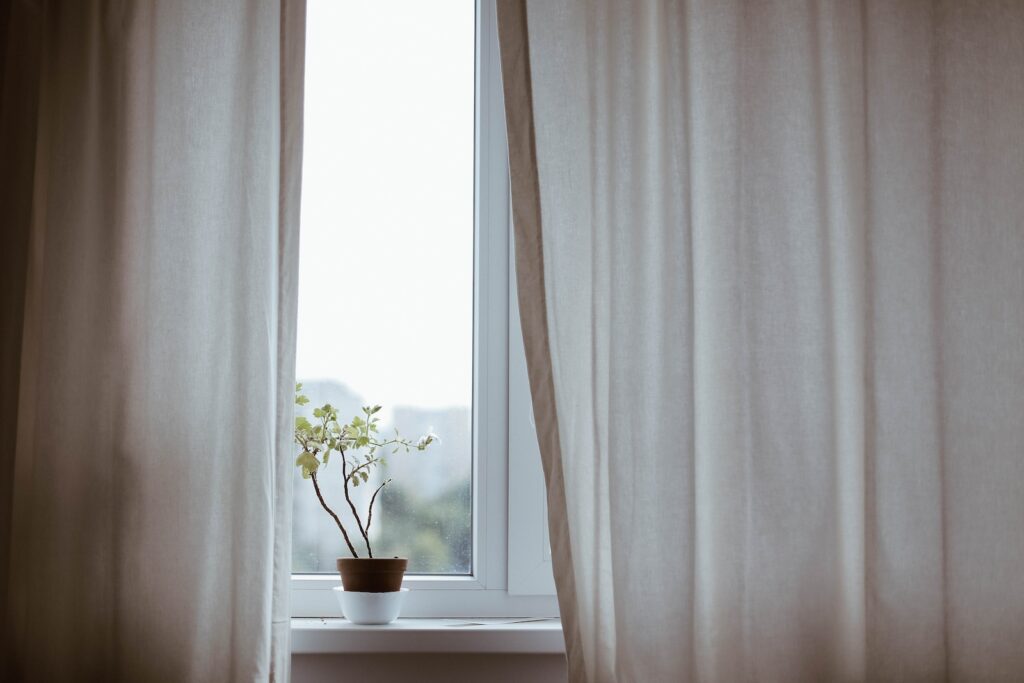Are you tired of high energy bills but don’t want to replace your windows? You’re in luck! There are several ways to make your windows more energy efficient without the cost and hassle of replacement.
First, try applying weatherstripping to seal any gaps between the window frame and sash. This will prevent drafts and keep the warm or cool air inside your home. Additionally, applying window film can help insulate your windows and reduce heat transfer. With these simple tips, you can save money and energy while keeping your current windows intact.

Windows are an essential part of any home, providing natural light and ventilation. However, they can also be a significant source of energy loss, leading to higher energy bills and a less comfortable living space. Many homeowners think that replacing their windows is the only solution, but there are several ways to make your windows more energy-efficient without spending a fortune.
1. Use Window Insulation Film
Window insulation film is a thin plastic sheet that you can apply to your windows to reduce heat loss. It works by creating an insulating layer of air between the film and the glass, which helps to trap heat inside your home. Window insulation film is easy to install and can significantly reduce your energy bills. You can buy it at any hardware store or online.
To install window insulation film, clean your windows thoroughly and cut the film to the size of your window. Then, apply the film to the glass, using a hairdryer to remove any wrinkles or bubbles. You can also use double-sided tape to secure the film to the window frame.
2. Install Window Shades or Blinds
Window shades or blinds can help to reduce heat loss by providing an extra layer of insulation. They also help to block out the sun’s heat and glare during the summer months, reducing the need for air conditioning. You can choose from a variety of materials and styles, including roller shades, cellular shades, and wood blinds.
To install window shades or blinds, measure your windows and choose the right size and style for your needs. Then, mount the brackets and install the shades or blinds according to the manufacturer’s instructions.
3. Use Weatherstripping
Weatherstripping is a material that you can use to seal gaps and cracks around your windows, preventing cold air from entering your home. It’s easy to install and can help to reduce your energy bills by up to 30%. You can choose from a variety of materials, including foam, vinyl, and felt.
To install weatherstripping, clean the surface around your windows and measure the length of the gaps and cracks. Then, cut the weatherstripping to the right size and apply it to the gaps using adhesive or nails.
4. Install Window Film
Window film is a thin, transparent sheet that you can apply to your windows to reduce heat gain during the summer months. It works by reflecting the sun’s heat and glare, helping to keep your home cool and comfortable. Window film is easy to install and can be removed when it’s no longer needed.
To install window film, clean your windows thoroughly and cut the film to the size of your window. Then, apply the film to the glass, using a squeegee to remove any air bubbles. You can also use a hairdryer to remove any wrinkles.
5. Use Draft Stoppers
Draft stoppers are long, narrow pillows that you can place along the bottom of your windows to prevent cold air from entering your home. They’re easy to make or buy and can significantly reduce your energy bills. You can choose from a variety of materials, including foam, fabric, and wool.
To use draft stoppers, place them along the bottom of your windows, making sure they’re snug against the frame. You can also use weatherstripping to seal any gaps or cracks around the stoppers.
6. Install Energy-Efficient Curtains
Energy-efficient curtains are specially designed to reduce heat loss during the winter months and heat gain during the summer months. They’re made from thick, insulated materials that help to trap heat inside your home, reducing the need for heating and cooling. You can choose from a variety of styles and colors to suit your decor.
To install energy-efficient curtains, measure your windows and choose the right size and style for your needs. Then, mount the brackets and install the curtains according to the manufacturer’s instructions.
7. Add Window Quilts
Window quilts are thick, insulated covers that you can place over your windows to reduce heat loss. They’re easy to make or buy and can significantly reduce your energy bills. Window quilts are particularly effective in old, drafty homes that have single-pane windows.
To use window quilts, measure your windows and cut the quilt to the right size. Then, attach it to the window frame using Velcro or magnetic strips. You can also use weatherstripping to seal any gaps or cracks around the quilt.
8. Seal Your Windows with Caulk
Caulk is a flexible material that you can use to seal gaps and cracks around your windows, preventing cold air from entering your home. It’s easy to apply and can help to reduce your energy bills by up to 20%. You can choose from a variety of materials, including silicone and latex.
To seal your windows with caulk, clean the surface around your windows and remove any old caulk or paint. Then, apply the new caulk to the gaps and cracks, using a caulking gun. Smooth the caulk with a wet finger or a caulking tool.
9. Use Window Inserts
Window inserts are removable, insulated panels that you can place over your windows to reduce heat loss. They’re easy to install and can significantly reduce your energy bills. Window inserts are particularly effective in old, drafty homes that have single-pane windows.
To use window inserts, measure your windows and cut the panels to the right size. Then, place them over your windows, making sure they’re snug against the frame. You can also use weatherstripping to seal any gaps or cracks around the inserts.
10. Upgrade Your Window Treatments
Upgrading your window treatments can make a significant difference in your home’s energy efficiency. You can choose from a variety of options, including insulated curtains, cellular shades, and reflective blinds. Look for treatments that are designed to reduce heat loss and gain, and choose materials that are durable and easy to clean.
In conclusion, making your windows more energy-efficient doesn’t have to be a complicated or expensive process. By following these tips, you can reduce your energy bills and create a more comfortable living space for you and your family. Try one or more of these solutions today and start enjoying the benefits of a more energy-efficient home.
Frequently Asked Questions
Here are some common questions about how to make windows more energy efficient without replacing them:
1. What are some ways to make windows more energy efficient?
There are several ways to make your windows more energy efficient without replacing them. One option is to install weatherstripping around the edges of the window to prevent drafts and leaks. You can also apply window film to the glass to reduce heat transfer. Adding curtains or blinds to the windows can also help to insulate the space by reducing the amount of heat that enters or leaves through the windows.
Another way to improve energy efficiency is to seal any gaps around the window frame using caulk or foam sealant. This will help to prevent air from escaping or entering through the gaps, which can make your home feel more comfortable and reduce your energy bills.
2. How does weatherstripping help to make windows more energy efficient?
Weatherstripping is a material that is applied to the edges of a window to create a seal between the window frame and the sash. This helps to prevent air from escaping or entering through any gaps or cracks around the window. By reducing the amount of air that flows through the window, you can improve the energy efficiency of your home and reduce your heating and cooling costs.
There are many different types of weatherstripping available, including adhesive-backed foam tape, felt, rubber, and vinyl. Make sure to choose a weatherstripping material that is appropriate for your window and that will provide a tight seal around the edges.
3. What is window film and how does it help to make windows more energy efficient?
Window film is a thin, transparent material that is applied to the glass of a window to reduce heat transfer. The film works by reflecting some of the sunlight and heat back outside, while still allowing light to pass through. This can help to keep your home cooler in the summer and warmer in the winter, which can improve energy efficiency and reduce your utility bills.
There are many different types of window film available, including solar control films, low-e films, and decorative films. Make sure to choose a film that is appropriate for your needs and that will provide the level of energy efficiency you require.
4. Are there any DIY solutions for making windows more energy efficient?
Yes, there are several DIY solutions for improving the energy efficiency of your windows. One option is to make your own draft stoppers using fabric and stuffing, which can be placed at the bottom of the window to prevent drafts from entering. You can also create your own window insulation using bubble wrap and double-sided tape, which can be applied to the glass to reduce heat transfer.
Another DIY option is to create your own window film using clear plastic wrap and a solution of water and dish soap. This can be applied to the glass and will create a temporary film that can help to reduce heat transfer. While these solutions may not be as effective as professional options, they can still make a noticeable improvement in energy efficiency.
5. How much can I expect to save on my energy bills by making my windows more energy efficient?
The amount you can save on your energy bills by making your windows more energy efficient will depend on a variety of factors, including the size of your home, the age and condition of your windows, and the type of improvements you make. However, studies have shown that making energy-efficient upgrades to your home, including improving your windows, can reduce your energy bills by up to 30% or more.
While the upfront costs of making these upgrades may be significant, the long-term savings can make it a worthwhile investment. Additionally, there may be financial incentives available, such as tax credits or rebates, that can help to offset the initial costs of the upgrades.
Making Old Windows More Efficient
In conclusion, making windows more energy efficient without replacing them can be a simple and cost-effective solution to save energy and money. By implementing some of the tips mentioned in this article, such as using weatherstripping or applying window film, you can reduce heat loss and gain, and improve insulation.
Furthermore, choosing the right window treatments, such as blinds or curtains, can also help to reduce energy consumption and increase comfort. These options not only provide insulation but also add a decorative touch to your home.
Finally, it is important to maintain your windows regularly to ensure they are functioning optimally. This includes cleaning and checking for any gaps or cracks that might allow air to escape. By taking these steps, you can enjoy a more energy-efficient home without the need for costly window replacements.


